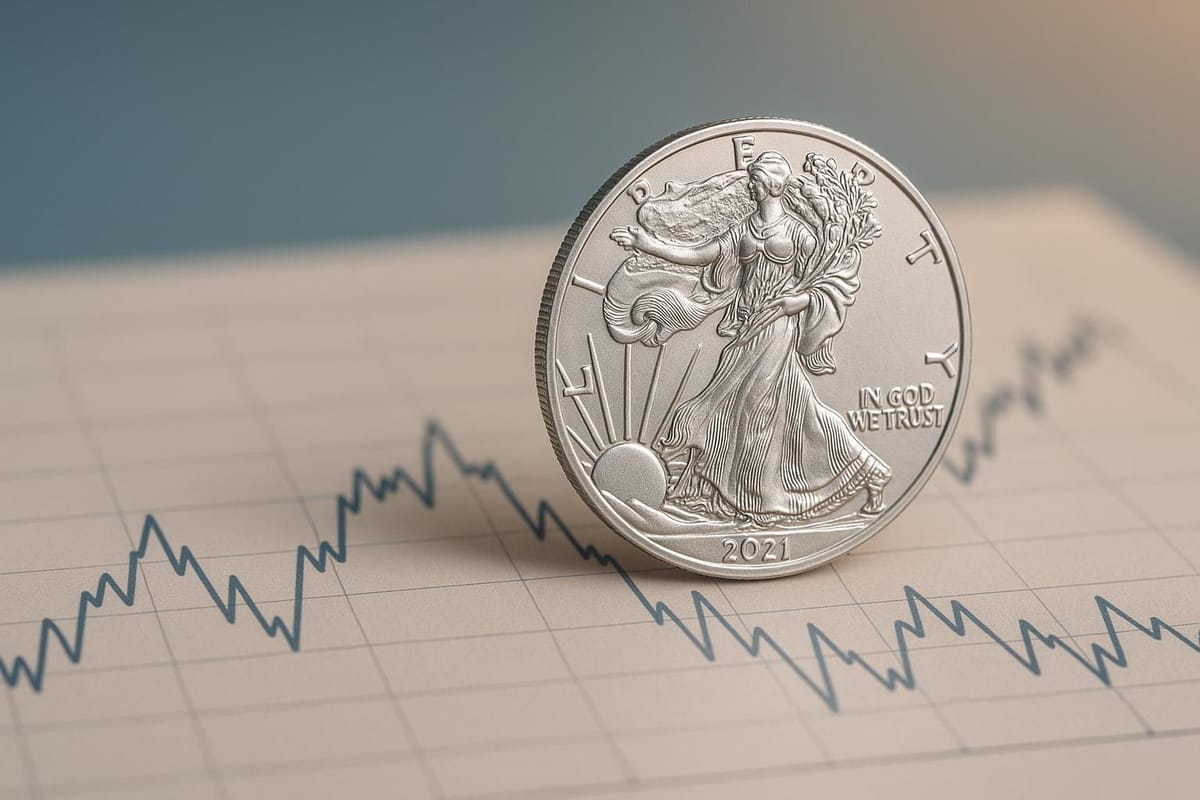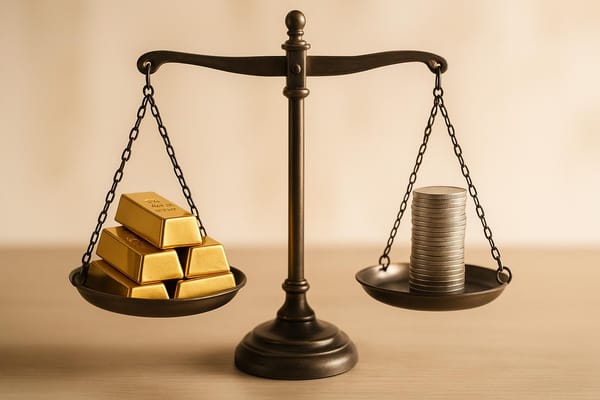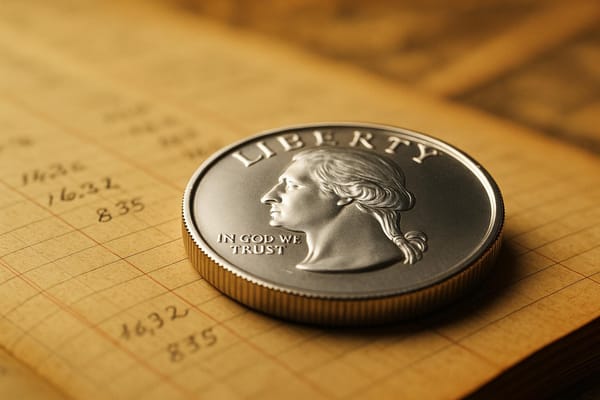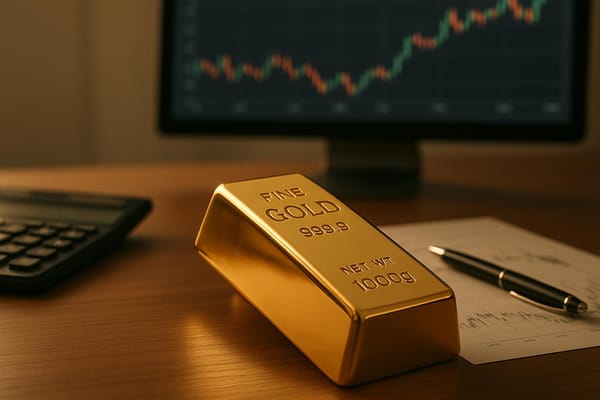Silver Price Volatility: Causes and Solutions
Explore the factors driving silver price volatility and investment strategies to navigate this dynamic market.

Silver prices move fast and can change a lot, giving both chances and risks for people who put money in it. Just now, silver reached $36.73 per ounce (June 2025), which is a 20% jump this year. Here's what makes it go up:
- Need for Work: We might use over 700 million ounces in 2025, with solar panels alone taking up 14% of all that’s used.
- Money Moves: Things like price jumps, how strong the U.S. dollar is, and loan costs all play big parts in setting prices. A weak dollar and high price jumps often push up silver's worth.
- Not Enough Silver: The world has made less silver than needed for the last four years, with a 148.9 million-ounce gap in 2024.
Main Ways to Put Money in Silver:
- Real Silver: It's safe but you must pay for keeping it and for insurance.
- Silver ETFs: Simple to buy and sell but you don't hold it yourself and might pay more tax.
- Future Deals: Big risk but big possible gains for those who know how.
Quick Tip:
To deal with how wild silver can be, have a mix in what you own, use stop-loss orders, and think about both real silver and ETFs for both safety and ease.
Silver’s use in stuff and its pull as an investment make it very quick to react to market changes. Keeping up with money shifts and big events around the world is key if you want to do well in this jumping market.
Silver Market Volatility - Will It Continue?
Why Does Silver Price Change So Much
The price of silver moves due to need in business, the state of the economy, and world affairs. These linked things make silver's price very up and down in the market.
Need in Business and Changes in Supply
Business uses make up about 55% of all the world's need for silver, which means changes in big businesses can greatly shift prices.
Look at the solar power area, for instance - it uses over 200 million ounces of silver each year, about 20% of all it needs. As Michael DiRienzo, the head of the Silver Institute, says:
"The electrification of the world is really providing a boon to silver."
More and more people want solar panels, and this need is hiking up the use of silver. In the same way, electric cars, which use more silver than old cars, together with new tech like 5G and small-scale tech, make the need for silver even greater.
On the other hand, it's tough to get more silver quickly due to limited supply. About 85% of silver comes from mines that handle many metals, not just silver. For instance, China alone uses over 150 million ounces of silver each year for making stuff. When everyone wants more silver but there isn’t enough, prices jump up. But if the economy does poorly, the need for silver drops, and so do the prices.
Yet, it’s not just the need from businesses that shakes the price of silver. Big economy shifts also play a huge part.
Economy Moves That Swing Silver Prices
Three main economy movements shape silver prices: inflation, interest rates, and the power of the U.S. dollar.
First, the U.S. dollar ties directly to silver. If the dollar gets weak, silver gets cheaper for those using other money types, which lifts demand. A strong dollar does the opposite.
Inflation too makes people want silver as a safe place to store value. Like in the 1970s, when high inflation made silver prices shoot from $1.75 to $49.45 per ounce - a 2,726% jump. Again, during the 2008 crisis, fear of inflation pushed prices from $9 to near $50 by 2011. The recent money given out due to COVID-19 also made inflation jump, and silver hit $28 per ounce in 2020.
Interest rates matter too. When they are low, silver looks better than profit-earning savings. But high rates pull people to those savings instead.
Past tries to control the market show these moves too. Like when the Hunt brothers tried to own the silver market in the late 1970s. They pushed prices up only for it to drop hard after rules stepped in.
Seeing these economy shifts is key to know market risks. And there’s more; big world events sway silver prices too.
World Fights and Market Feel
World fusses, trade fights, and unsure politics often make people look to silver as a safe choice. Trade wars can mess up how we get resources and hike up prices.
Market mood also changes fast with news or events. Good news might lower the pull to safe spots, while bad news or new fights can make people buy more silver.
Recent times show this back and forth. On June 18, 2025, silver hit $37.24 per ounce, the top since February 2012. Silver funds did better than gold ones for three months as of June 2025, showing solid interest. Also, the gold-to-silver rate was 94 in June 2025 (down from 105 in April yet over its old average of 60), hinting at market mood.
As Reuters noted:
"Gold's surge has been driven by genuine fear and flight to safety. Silver's move, while notable, appears to be more speculative than defensive."
Silver holds a special spot as both a tool for work and a choice for money-saving. This mix makes it very quick to react to changes in the economy and world events, bringing a kind of risk that those who put money into it must handle with care.
How to Handle Silver Price Volatility
Managing silver's price swings - known to be 2–3 times more volatile than gold - requires a solid risk management strategy.
Risk Management Methods
One effective way to manage risk is by using stop-loss orders, which automatically sell your silver holdings when prices hit a predetermined level. This helps limit potential losses. However, setting these limits requires careful consideration due to silver's inherent volatility. Pairing stop-loss strategies with a diversified investment portfolio can further cushion the impact of price fluctuations.
Diversification to Reduce Risk
Diversification is a powerful tool to stabilize returns. By spreading your investments across uncorrelated asset classes, including precious metals, you can reduce your exposure to silver's price swings. Within the precious metals category, adding gold, platinum, and palladium to your portfolio provides additional balance. Each metal reacts differently to market dynamics - silver is heavily influenced by industrial demand, while gold, for instance, often serves as a hedge during economic uncertainty. Beyond metals, including assets like stocks, bonds, and real estate in your portfolio offers even greater stability.
Silver Investment Options
When it comes to investing in silver, there are three main approaches, each with its own pros and cons for managing volatility:
-
Physical Silver:
Owning physical silver gives you direct control without counterparty risks. However, it comes with added costs for storage, insurance, and transactions. This option is best suited for long-term investors looking for security. -
Silver ETFs:
Exchange-traded funds (ETFs) like iShares Silver Trust (SLV) or abrdn Physical Silver Shares ETF (SIVR) provide a liquid and cost-efficient way to gain exposure to silver. With low expense ratios of 0.5% and 0.3%, respectively, they are attractive options. However, be mindful of potential higher tax rates unless held in tax-advantaged accounts. -
Silver Futures Contracts:
Futures allow you to control large amounts of silver with relatively small capital through leverage. While this can magnify gains, it also increases the risk of significant losses, making it a better choice for experienced investors.
A balanced approach might combine physical silver for long-term security with ETFs for greater flexibility and tactical adjustments.
It’s worth noting that silver's strong industrial demand supports its long-term value, even if short-term price swings can be dramatic.
Ways to Put Money in Silver
To put your money in silver, the right way to do it changes based on what you want from your money, how much risk you can take, and how much you want to be hands-on with your money. Below, we lay out the main differences among the ways you can invest in silver, so you can match your plan with your bigger money goals.
Table: Ways to Invest in Silver Compared
| Way to Put in | Easy to Sell | Keeping Needs | Costs to Trade | Risk of Loss | Who Owns It |
|---|---|---|---|---|---|
| Real Silver | Hard – need to find a buyer | A lot – need safe place (and insure it) | More costs ($0.75–$8.00 over spot) | Less risk from others | You own it |
| Silver ETFs | Easy – sold like stocks | None – fund takes care of it | Lower costs (0.30%–0.50%) | More risk from others | You don't own it yourself |
| Silver Futures | Easy – sold on markets | Not needed | Some money down and fees | Very risky due to borrow | You have a paper claim |
Let's look at these key points and how they matter to you as a money person.
Easy to Sell and Costs
How fast you can sell things changes a lot. Silver ETFs are the easiest to sell fast, just like stocks. But for real silver, you'll need to work harder - you must find someone to buy it, and this may take time, more so when the market is all over the place. ETFs are better if you need to change things fast.
When talking about costs, real silver has higher first costs. For example, American Silver Eagles often have extra costs of $5–$8 over the main price, while 100-ounce bars are $0.75–$1.92 extra. Costs for keeping it safe add up too, from $50–$300 each year for a safe box to 0.25%–1.0% of the silver's worth for expert safekeeping. Over five years, these costs can be 10–20% of what you first put in, while it's around 1.5% for ETFs in the same time.
Taxes
Taxes can really change how much you make back. Silver ETFs are seen as collectibles by the IRS, so long-term gains are taxed up to 28%, unlike the 20% rate for stocks. For big, long-term money put in, this can eat into what you make.
Risk and Who Owns It
Each way has its own risk part. With real silver, you cut out middleman risk - you own the metal right - but you must keep it safe and get it insured. Silver ETFs drop worries about keeping it safe but add middleman risk, as you trust the fund's truth.
For future deals, risks are even more. Each silver futures contract deals with 5,000 troy ounces, but you can get smaller 1,000-ounce ones too. The big bets you make in futures trading can make both wins and losses bigger, not good for new folks or those who want safe, long-term money growth.
Market Ways and Mixed Plans
The silver market has seen less supply for five years, missing 474 million ounces since 2021. This small supply, with the need from industries going over 700 million ounces each year by 2025, makes silver's future look good. Those with real silver might get more for its rareness, while ETF folks get direct link to silver's main price without the trouble of keeping it.
Many wise investors use both ways. Real silver stands against money risks and keeps value, while ETFs let you trade and change your plan easier. This mixed way helps you use the strong points of each way while cutting down their weak spots.
What Silver Buyers Need to Know
Learning what moves silver prices helps buyers choose well. Here are some key points to think about:
Silver has two uses - it's a valuable metal and also helps in making things. This makes it move up and down in price more than gold, up to 3 times as much. Yet, this up and down can mean more money if you know what shapes its market.
Silver is mostly used to make things. Every year, people use over 700 million ounces, which is more than half of all the silver used. Also, 85% of silver comes from mines that get more than one type of metal and can’t quickly make more silver to meet big needs from sectors like eco-friendly tech and gadgets. This is good for those who plan to keep their money in silver for a long time.
In June 2025, the price of silver went up to about $36 per ounce, a jump of almost 24% from the year before. But these figures are still way lower than the highest prices ever, when you think about inflation. For example, the 1980 high of $50 would be around $195 today, and the 2011 high of $49.80 would be about $70 in 2025 money.
"These moves can be brutal - 20-30% corrections even within ongoing bull markets." – Lobo Tiggre
Good risk control is key. Pros say to put 5-10% of your money in real silver to stay safe from rising costs. Stay away from high-risk paper deals, and think about using steady buying to ease the effect of price shifts. A mix of real silver and ETFs can give both safety and choice.
In the past, silver has done better than the S&P 500 in three of the last eight bad times. But, its ups and downs can cut both ways. For instance, silver's value fell over 40% in the 2008–2009 bad time, showing why it's vital to think for the long run.
To do well in this area, keep up with the news. Watch the economy, big world events, and shifts in how much industries need. Sites like Gold and Silver.net offer help like live price checks, market views, and learning bits to help you keep up in this always-shifting field.
FAQs
What makes silver prices go up and down, and how can people deal with the risks?
Silver prices can jump or fall a lot. They are moved by things like big changes in the economy (such as inflation, interest rates, and what the government does), world events, and changes in how much silver businesses need. These things can make silver prices move in hard to guess ways, making silver a thrilling but risky thing to put money in.
To deal with these risks well, people can try a few ways:
- Mix up your money: Put silver together with different things to lower risk.
- Use stop-loss orders: These can stop big money losses by auto-selling silver if prices fall too much.
- Use tools to cover risks: Things like agreements about future prices or silver-focused exchange funds can help keep things steady when prices change a lot.
By using these methods, people can feel more sure when they step into the silver market, even when things are unsure.
How does the need for silver in big fields like solar energy and electronics change silver costs?
The Power of Need for Silver in Costs
The need for silver in big fields such as solar energy and electronics has a huge effect on silver costs. Look at solar panels - by 2030, they're set to eat up about 20% of the world's silver. This jump in need often makes prices go up as big fields fight for not much silver.
Why is silver so key? Its top ability to lead. This feature makes it a main pick in making electronics. As tech gets better and ways to use clean energy rise, the need for silver will likely go up, making costs shift. For those who put money in, watching these moves can give helpful tips about the silver market.



